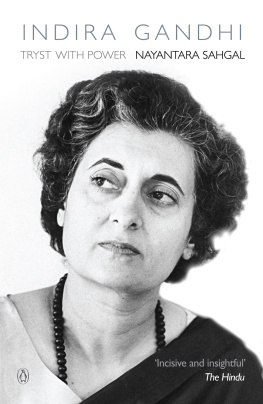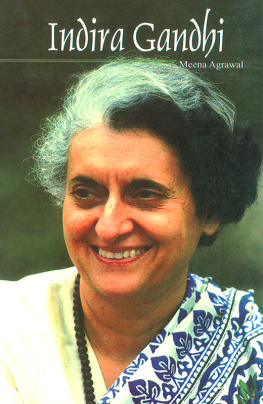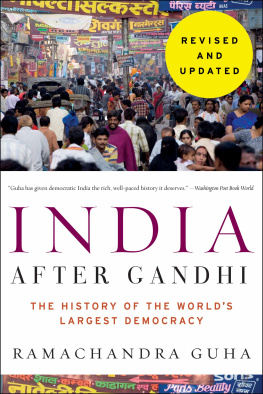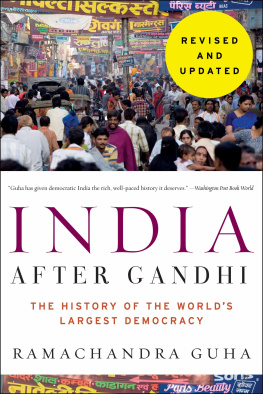STEPHEN RILEY
In Memory
CONTENTS
PART ONE
Indira Gandhi
Home is where one starts from.
As we grow older the world becomes stranger,
The pattern more complicated
In my end is my beginning.
T.S. Eliot, East Coker from
Four Quartets
ONE
Descent from Kashmir
D AILY NINETY-MINUTE FLIGHTS connect Srinagar, the capital of the Indian state of Jammu and Kashmir, with Delhi. But my letter to the Kashmiri Chief Minister, Farooq Abdullah, took six weeks to reach him, and according to the date of the reply written by his acting assistant principal secretary, the Chief Ministers response took another five weeks to get back to me in Delhi. Had our letters languished on some functionarys desk, in a forgotten mail bag, got lost in the crush of a bustling post office? It was not going to be easy to get to Kashmir. Nevertheless, the Chief Ministers reply brought good news: Farooq Abdullah would be pleased to talk to me about the late Prime Minister Indira Gandhi. We could meet either in Delhi or Srinagar, according to my convenience.
Srinagar today like most of the rest of Kashmir is no longer an easy place to visit. Once the idyllic pleasure ground of the British Raj and later a tourist resort for Indian, European, American and Australian tourists and backpackers, Kashmir is now a war zone the disputed territory fought over by two hostile nations that were once one: India and Pakistan. Those writers who go to Kashmir these days are not biographers but journalists covering an internecine conflict that rumbles, flares up, dies down and rumbles on year in and year out.
After decades of obscurity, Kashmir now makes global headlines. Several years ago, Kashmiri separatists kidnapped and murdered a group of Western climbers trekking in the Himalayas. In the spring of 1998 India and Pakistan set off nuclear devices, making Kashmir the likeliest flash point of the next nuclear holocaust. A year later, their armies were at war on the border near Kargil. In the spring of 2000, when President Clinton visited the subcontinent, a village of Sikhs was massacred allegedly by militants to underscore the fact that the war still raged on.
Most of the Srinagar hotels are now boarded up and derelict. Those still operating house security forces. Rows of khaki laundry flap on clothes lines in the hotel gardens. Black-booted soldiers in helmets and flak jackets patrol the streets. The traffic is mainly army jeeps and trucks. Gone are the hawkers, pavement ear-cleaners and street barbers. Ordinary life of a sort goes on here. But the atmosphere in the shops and bazaars is often tense and faces are sullen or downcast.
At the heart of Srinagar lies Dal Lake sluggish, furry green, congealed with pollutants. From time to time, the lake belches methane gas, releasing a putrid stench into the air. No kingfishers fly overhead because no fish could live in this lake. When Indira Gandhi appointed her cousin B.K. Nehru as Governor of Kashmir in 1982 at a time when the present conflict might still have been averted she personally briefed him. She said not one word about the volatile political situation in the state. Instead she spoke with urgency and passion of the need to clean up Dal Lake before it was too late. Nearly twenty years later, here and there, a rotting houseboat shudders on its stagnant surface.
Kashmir today is not the Kashmir Indira Gandhi knew. Kashmir today is India fouled and polluted India lacerated the unhealed and unhealing wound of Partition. In 1947, at independence, when British India was carved into the two sovereign nations of India and Pakistan, Kashmir, the only Muslim majority state in India, acceded to a secular India rather than an Islamic Pakistan. The Hindu Maharaja of Kashmir made this choice for his Muslim majority population. But he made it under duress and to no ones satisfaction.
Since 1947 India and Pakistan have fought three full-scale wars over Kashmir, a place of minor material or economic importance to either country. But Kashmir possesses enormous significance to Indians and Pakistanis conflicting, irreconcilable conceptions of the subcontinent. Kashmir has been bitterly and bloodily disputed because it has come to symbolize on the one hand, the ideal of secular democracy to Indians, and on the other, the validity of a Muslim homeland to Pakistanis. Nuclear devices, bloody skirmishes in the mountains of Kargil, village massacres, more bombs and assassinations in Srinagar these are just the most recent chapters in a story that goes back more than half a century.
But my story the life of Indira Gandhi goes back even further. It begins in a remote Himalayan fastness of snow-capped mountains, meadows carpeted with alpine wildflowers, rushing rivers that flow into tear-shaped lakes, and valleys dark with fir and pine forests where the gigantic chinar tree bursts into fiery-red blossoms every autumn until the snows come and extinguish all colour from the land.
This Kashmir a place of beauty and transcendence was the bedrock of Indira Gandhis life, the thing to which she held fast, which she sought to recover again and again in the course of her long life. Kashmir was a land that nourished and solaced her. We were Kashmiris, Indiras father, Jawaharlal Nehru, writes on the first page of his Autobiography. Indira Gandhi embraced this statement and put it into the present tense - I am Kashmiri. Throughout a rootless, chaotic existence, in which she never had a stable family life or owned a house of her own, Kashmir remained Indira Gandhis anchor, her hearts home.
Her story begins as it ends in Kashmir.
It opens in Kashmir but then almost immediately leaves it. Indira Gandhis biography, like all biographies, does not begin abruptly, at the moment of birth, but rather at what seems to the biographer a decisive moment long before. And this moment some two hundred years before Indira was born in November 1917 was one of banishment a fall or expulsion from paradise. In the opening chapter of his Autobiography, Descent from Kashmir, Nehru writes, over two hundred years ago, our ancestors came down from that mountain valley to seek fame and fortune in the plains below. From their lofty, Edenic home in the Himalayas, Indira Gandhis forebears were exiled to the hot, arid plains of north-central India.
The particular ancestor Nehru refers to was a Hindu Pandit one of the Brahmin elite of Kashmir named Raj Kaul, a Sanskrit and Persian scholar, who left Kashmir around 1716 for Delhi. Here he became a member of the court of the Mughal Emperor Farukhsiyar who granted Raj Kaul a house situated on a canal in the city. Raj Kauls descendants came to be known as Kaul-Nehrus after nahar, which means canal, and in time this was shortened to Nehru.
From the beginning, the Nehru family was allied to power. First this was the power of the Mughal Emperor and when his empire declined, the might of the British. Raj Kauls great-grandson, Lakshmi Narayan, became one of the first Indian vakils, or lawyers, of the East India Company in Delhi, and his son, Ganga Dar, was a police officer in the city when the Mutiny broke out in 1857. In the upheaval of the 1857 uprising, Ganga Dar fled with his family to Agra. He died four years later and three months after his death his wife gave birth to a posthumous son who was named Motilal.
Motilal Nehru Indira Gandhis grandfather was raised by his elder brother, Nand Lal, and Motilal, like his brother, trained as a lawyer. Like his brother, too, Motilal married while still in his teens and had a son. But both wife and son died in childbirth before Motilal was twenty. By 1887, the year that Nand Lal died and Motilal assumed responsibility for the family as the eldest surviving son, Motilal had remarried a beautiful young woman, also of Kashmiri extraction, named Swarup Rani. The young couple moved to Allahabad, in the United Provinces (as they were then called) some 500 miles from Delhi, where Motilal pursued what quickly became a brilliant legal career.










